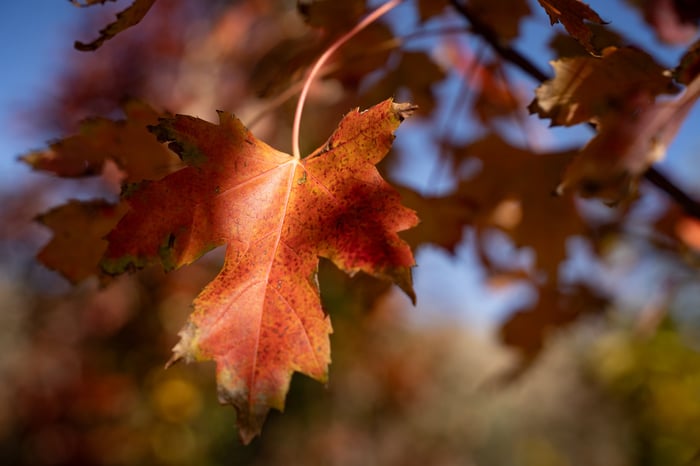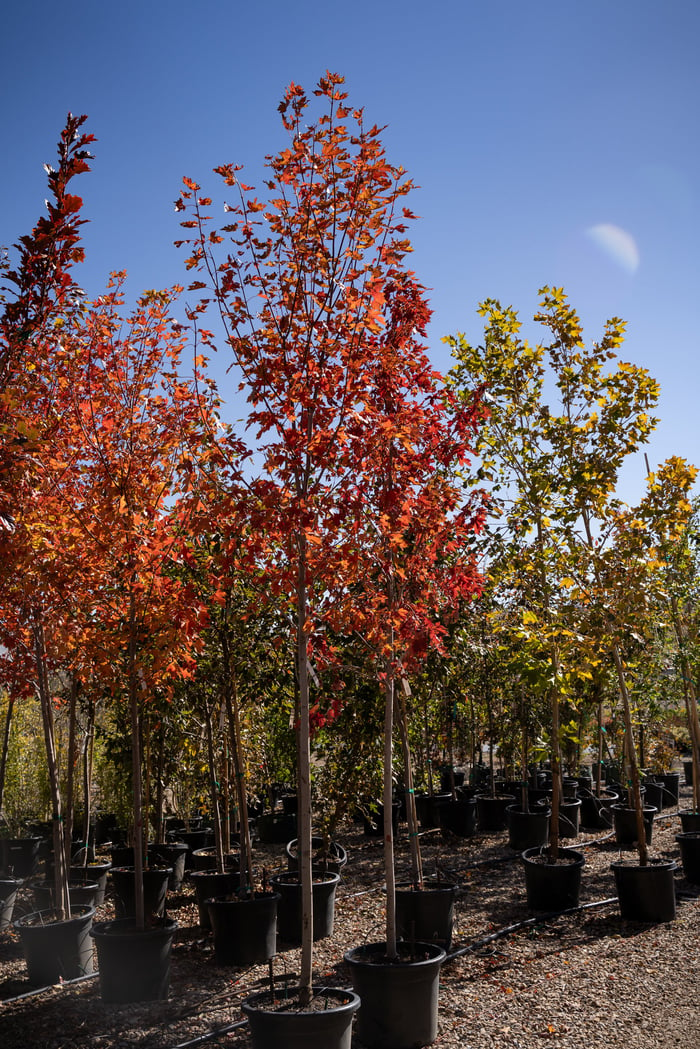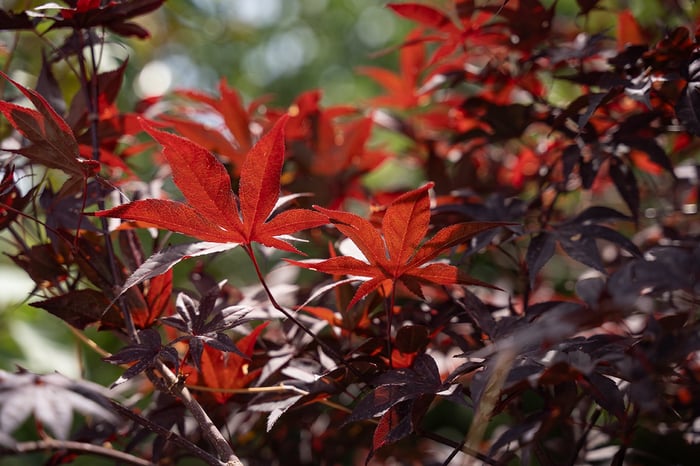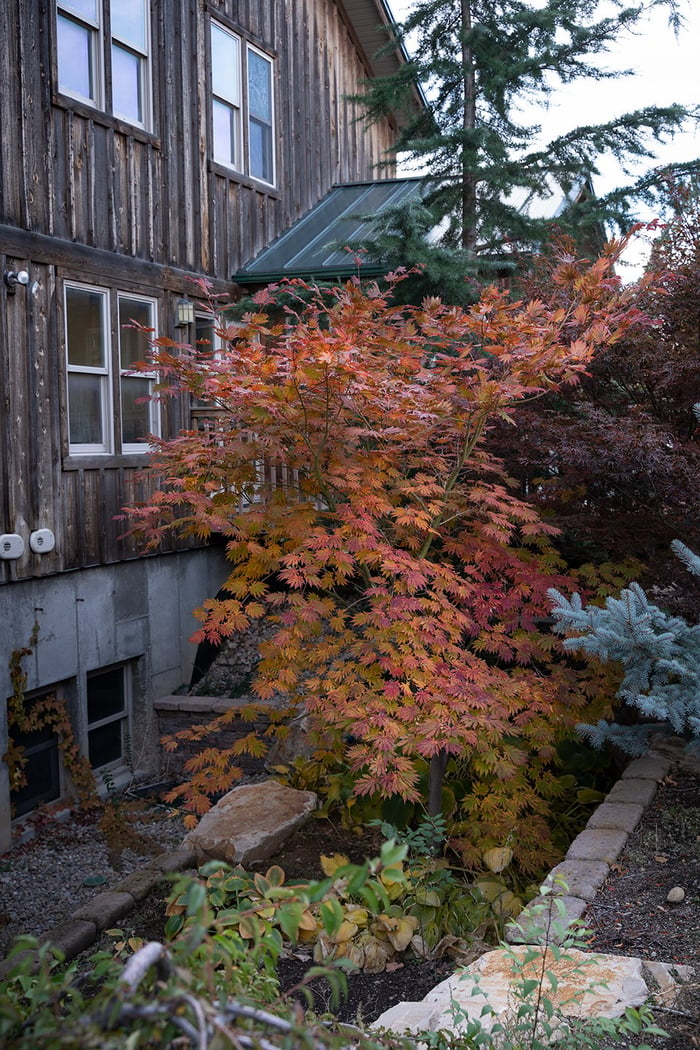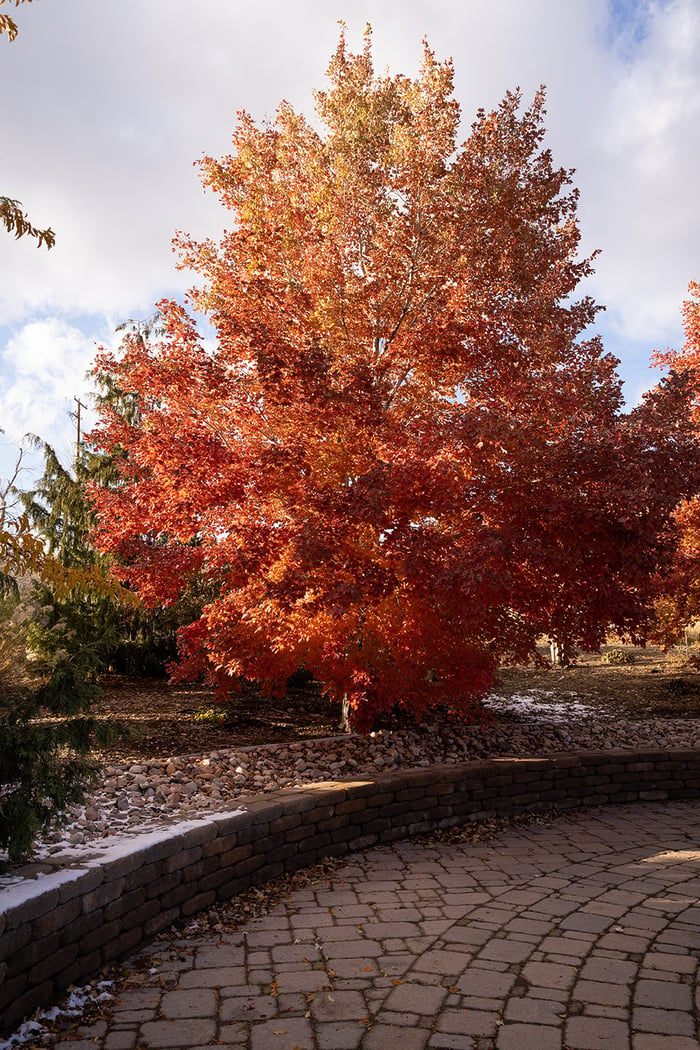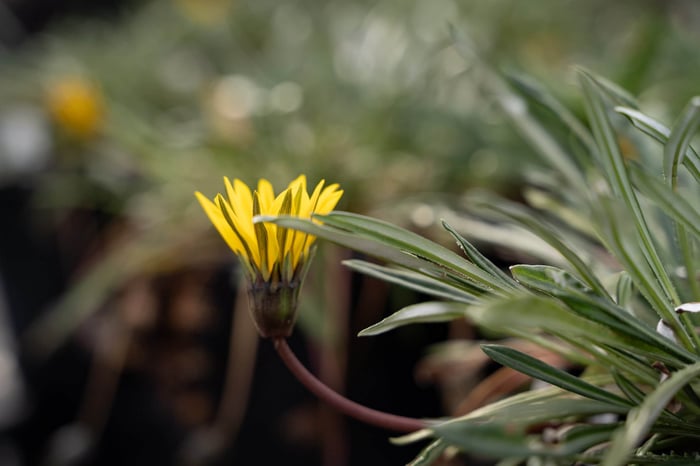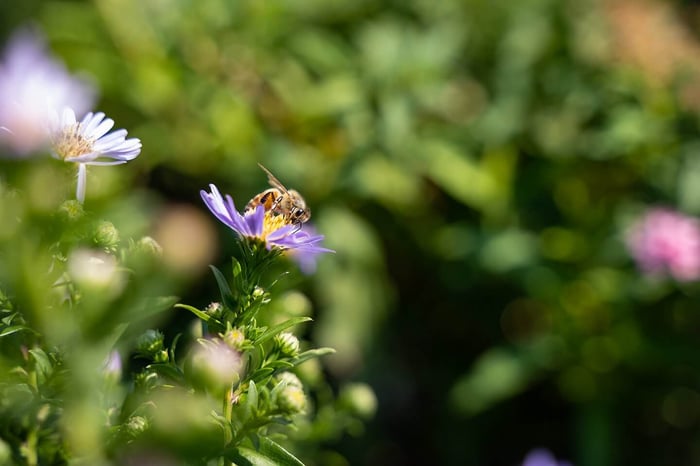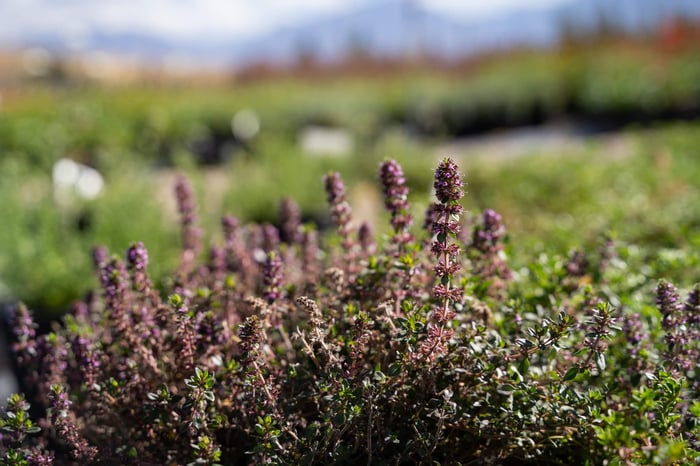Let’s pretend that you want to do a small project that will brighten your landscape for years to come. The easiest choice would be to plant a tree—one that will bring life, shade, and color to your yard. Since you love bright red fall leaves, you may want to plant the popular Autumn Blaze Maple, a stunning fall specimen, indeed! The trouble is, this is Utah. If your Autumn Blaze Maple, or any maple for that matter, is going to thrive in your yard, you need to understand some very important facts.
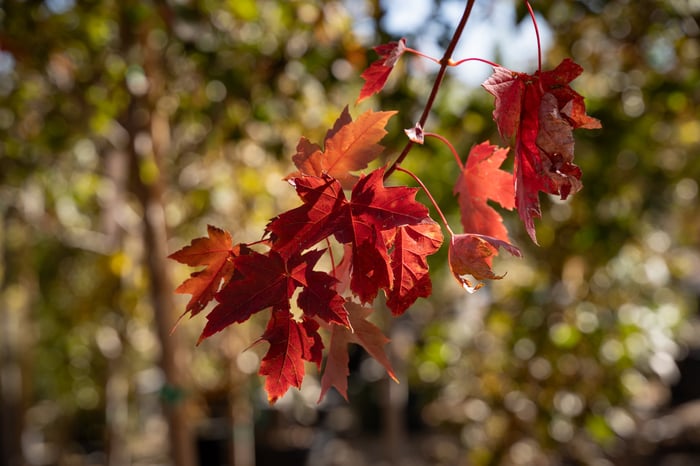 Autumn Blaze Maple in the Fall
Autumn Blaze Maple in the Fall
At one point, Autumn Blaze (Acer x freemanii 'Jeffersred' Autumn Blaze®) was touted as the ideal red maple for North America. It’s a hybrid maple known for fast growth, a strong upright shape, and exceptional red-orange fall color. For gardeners across our region, growing in elevations of 4,000 to 8,000+ feet, this maple promised to be a valuable addition. The big nurseries that created and sold this cultivar spent unbelievable amounts of money marketing this tree to the masses, and for good reason. It’s a fabulous tree. The hybrid combines the vivid red fall color of the Red Maple and the fast growth of the Silver Maple, offering striking visual impact and adaptability.
In many locations throughout the Intermountain West, this beautiful tree delivers as promised. If you live in an area where Autumn Blaze thrives, you will absolutely love this stunning tree! That said, your results WILL vary.
Making Autumn Blaze Maple Work For You
Here along the Wasatch Front the success of your maples depends on understanding our 'special' conditions: alkaline soils, hot dry summers, cold winters with wide temperature swings, strong winds, and a short growing season. Some of these threatening conditions can be mitigated through proper placement in the microclimates of your yard, others are simply deal breakers. We’ll start with those things that we CAN control, which means we’ll take the above list in reverse order.
Short Growing Season: We can't control the length of our growing season, but we can use microclimates to help a little bit. Because our last frost in the spring usually falls as late as April or early May, and the first frost of autumn can come as early as September, your maple trees will have a relatively short season of growth. This means that they won’t get quite as large as maples in other parts of the country quite as quickly, but they will still offer beautiful structure, color, and shade for your landscape.
Knowing that our growing season is shorter here, you may be surprised to learn that we usually recommend you plant your maples on the side of your home that is protected from winter sunlight. We do this because your tree needs consistent temperatures to thrive. More about that later.
Strong Winds: If you’re new to Utah, it won’t take long for you to realize that this area is prone to strong, dry winds in both the summer and winter. These winds will dry out any plant that you try to grow in your yard. Strong dry winds will have a serious effect on maples because their bark is very thin, especially during the first several years of growth.
The wind, so common in our region, will not only dry out leaves, it can also affect the trunk of the tree, drawing moisture through the bark. Wind can lead to broken branches and blow sand, ice crystals, and other material against the bark of your maples causing abrasions. These abrasions can lead to pest infestation or disease.
- To mitigate damage from harsh winds, be sure to plant your maples in a protected area. This is usually the leeward side of your home or some other structure in your yard. You can also use other trees, such as a line of junipers, as a wind block for your maples.
Cold Winters with Wide Temperature Swings: Winters in Utah are wild! That’s why we recommend that you use plants in your garden beds with a hardiness rating at least one step lower than the hardiness zone of your area. Hardiness zones are based on the AVERAGE winter temperatures in your area. They don’t take into account the extreme dips that can often last for several days. Many homeowners have lost plants during winter that simply couldn’t handle the wild temperature swings we have here. But it isn’t usually the cold that will kill your maples, it’s the winter sun.
You may be surprised to know that young maples (and all Japanese Maples) have very thin bark that cannot handle exposure to winter sunlight. During the cold months of winter, maples that are planted on the south side of a home or structure are exposed to the warm afternoon winter sunlight. This direct heat is amplified as it reflects from the walls of nearby structures, warming the bark just enough to awaken the cambium layer of the tree. That awakened cambium begins to draw water up the trunk in the late afternoon just in time for the sun to set and freezing temperatures to settle in.
Those cold temperatures will freeze the water in the cambium layer of your tree, destroying the cells of your tree and even cracking the bark. Over a period of just a few years, your maples can experience a slow death from dieback, attrition, and simple exhaustion. However, if you plant your maples on the north or north-east side of your home, they can thrive for years with little to no winter damage.
Hot Dry Summers: The dry heat we experience during the summer months in Utah can have a devastating effect on your trees. It’s best to plant your maples in the fall so they aren’t struggling against ever increasing temperatures as they establish roots. If they have fall, winter, and spring to strengthen their roots, they will be better able to handle the summer heat.
It also helps to plant them on the north or northeast side of a structure so they can be protected from the hot afternoon sun. Even so, you’ll need to increase their water during the hottest and driest months.
Watering with drip irrigation will allow you to water slowly and deeply, giving your trees a better opportunity to absorb water before it evaporates.
We also recommend 4 inches of mulch around your tree to help retain moisture and reduce weeds that compete for water. Be sure to keep the mulch a few inches away from the trunks of your trees to avoid damage. Water conservation is essential in Utah. Deep infrequent irrigation is better than frequent shallow watering.
Alkaline Soils: Before you purchase a maple tree, especially Autumn Blaze, be sure to test your soil. Autumn Blaze does not tolerate alkaline soil. It will thrive best with a soil pH of 5.5 to 7.0.
You will find resources all over the internet that tell you that you can amend alkaline soil to lower the pH adequately for maples. However, after several decades of growing plants throughout Utah and the Wasatch Front, we have found that no amount of soil amendments can sufficiently protect your maple trees from the challenges that come from high pH.
If you want maples that don't struggle with iron chlorosis and weak cellular structure, where you plant matters. In Utah, the soil pH increases as the elevation decreases, and the clay content of your soil increases the closer you get to the valley floor. This combination of heavy clay and alkaline soil will spell serious trouble for your maple trees, especially Autumn Blaze. It’s best to use this tree in high elevation areas such as Park City, Logan, or the Wasatch Front benches, where it thrives under ideal conditions.
If you visit Progressive Plants, you'll notice several beautiful October Glory Maples around our office. October Glory may be even more difficult to establish in this area than Autumn Blaze. The only reason why our maples have done so well, is because we had to remove several tons of soil around our office. We used heavy equipment and dug wide and deep to replace that soil, so the trees that are planted there aren't actually dealing with 'native' soil any longer.
- Your Water Matters: You also need to understand your water source. If you are watering your yard with culinary water, you can enjoy far more plants in your yard, but if you have secondary irrigation water, you’ll want to know where that water comes from. Water from Utah Lake is so heavily loaded with dissolved solids that it will actually kill many of your favorite plants. It can even increase the pH of your soil, making it even more alkaline than it already is. If you are watering your yard with water from Utah Lake, we recommend that you don’t plant maples in your yard.
Watering & establishment
For the first two years, give deep, infrequent soakings, about 1 to 1.5 inches of water per week. Use drip irrigation or soaker hoses to conserve water.
Reduce irrigation as winter approaches, but if your soil is dry during the winter months, be sure to water your maples every 3 to 6 weeks to prevent winter root desiccation.
Pruning, pests and winter care
Prune for structure in late winter while the tree is dormant, removing crossed or weak limbs. Autumn Blaze grows fast—regular training can help reduce damage from rubbing and split crotches.
Watch for leaf scorch during the summer months. Treat heat stress by adjusting your water and providing wind protection if necessary. Monitor for aphids and scale; these are rarely fatal but if you treat them early and quickly as populations rise, you can reduce stress on your tree.
Protect young trunks from sunscald and rodent damage with tree guards, paper wrap, or a light whitewash in winter.
Final Thoughts
Maples, like Autumn Blaze, can become impressive signature trees in many Intermountain gardens. We recommend that you take note of your elevation, soil structure, and water source before selecting trees for your yard. If your soil and water source allow for maples, be sure to plant them in locations where the microclimate will best suit their needs. Think of your landscape as a system—soil, water, microclimate and companion plants all working together. Plant trees in the fall, help the roots grow, protect trunks from winter stress, and you’ll be rewarded with dazzling fall color and trees that shade your yard for decades.
Stop by Progressive Plants or browse our online catalog to find the perfect trees and companion plants for your yard. We're open all year long to answer any questions you may have. Whether you’re planting a single statement tree or designing a layered yard with native shrubs and evergreens, our team is here to help you succeed wherever you live throughout the Intermountain West. Good luck, and happy gardening!

